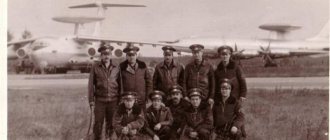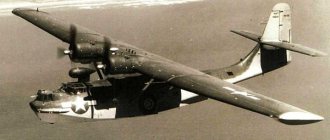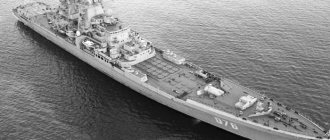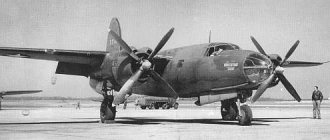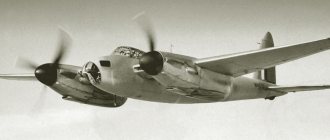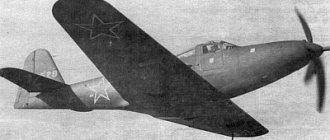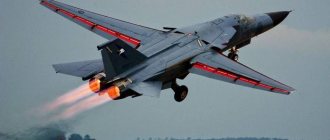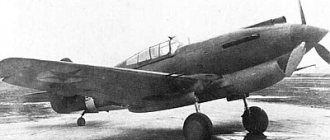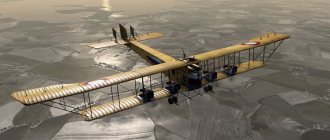In 1938, production of the new four-engine Boeing B-17 bomber began in the United States. However, at first the pace of its production did not satisfy the military, and the leadership of the US Army Air Force approached with a proposal to launch production of the B-17 under license. The company came up with a counter initiative - to develop its own four-engine bomber with higher flight characteristics.
On February 1, 1939, the US Army Air Forces issued the C-212 specification, which provided for the creation of an aircraft with a maximum flight speed of 482 km/h, a range of 4827 km, a ceiling of 10,670 m and a bomb load of 4 tons. The development of the machine from the beginning was carried out by a group of designers under the leadership of I. M. Laddon. The plane was a high-wing aircraft with a two-tail tail. A characteristic feature of the “Model 32” was the so-called. “Davis wing” - high aspect ratio, high rigidity and a special profile that minimizes drag. In this case, almost the entire internal space of the wing was used to accommodate fuel tanks. The power plant chosen was 14-cylinder Pratt & Whitney R-1830-33 air-cooled engines (1200 hp). Defensive armament, according to the preliminary design, consisted of 6 Browning rifle-caliber machine guns - one each in the nose, tail, top, bottom and two side mounts.
The design and construction of the bomber proceeded quite quickly - the Consolidated XB-24 prototype was flown on December 29, 1939. The aircraft showed very high flight performance - in particular, in terms of flight range with the same bomb load, it was significantly superior to the B-17. The company received large orders, incl. and export ones - from France (for 60 aircraft) and Great Britain (for 165 aircraft). The French contract was not implemented due to the defeat of this country, but aircraft were delivered to England. It was there that the B-24 received its name - "Liberator" . Serial production of the B-24, in addition to Consolidated (the plant in San Diego built 6,724 aircraft, and in Fort Worth - 3,034), was carried out (694 aircraft), North American (966) and Ford (6,792).
From 1941 to 1945 18,482 aircraft were built. Thus, the Consolidated B-24 Liberator became the most produced American aircraft of the Second World War and the most produced four-engine aircraft in aviation history .
Flight characteristics of the Consolidated B-24A “Liberator”
- Engines: Pratt & Whitney R-1830-33
- power, hp: 1200
- Wingspan, m.:
- Aircraft length, m: 19.43
- Aircraft height, m: 5.69
- Wing area, sq. m.:
- Weight, kg:
- empty aircraft: 13,600
- normal takeoff: 18,120
- maximum takeoff: 24,300
- Maximum speed, km/h: 470
- Climb time 3050 m, min: 5.6
- Ceiling, m.: 9300
- Flight range with bomb load 1815 kg, km: 3500
Main modifications of the Consolidated B-24 Liberator
YB -24 - pre-production batch. Engines R-1830-33 (1200 hp). Small arms - 6 12.7 mm machine guns (1 each in the bow, tail, top, bottom and two side mounts). Bomb load weight -3630 kg. Since January 1941, 7 vehicles have been built, 6 of them under the designation LB-30A were delivered to England.
LB - 30 V - R-1830-33 engines. On-board equipment according to British standard. Small arms - 6 7.7 mm machine guns (1 each in the bow, bottom and two side mounts, 2 in the tail mount). In 1941, 20 aircraft were manufactured for England (British designation Liberator Mk.l).
V -24 D - analogue of LB-30V for the USA. 1 12.7 mm machine gun is mounted in the bow, lower and side mounts, and 2 7.62 mm machine guns in the tail mount. Crew - 7 people. 9 units delivered.
"Liberator" Mk.II - small arms have been significantly strengthened: 4 7.7-mm machine guns in the top and tail turrets, 2 in the side mounts, 1 each in the bow and bottom mounts. The fuselage is somewhat lengthened. Since June 1941, 139 aircraft were manufactured under British orders, but 75 of them, after the United States entered World War II, became part of the US Army Air Force under the designation LB-30 (received armament from 8 12.7 mm machine guns - 2 in the upper turret , 2 in the tail installation, 1 each in the bow, lower and two side installations). Subsequently, 23 LB-30s were handed over to the British.
At -24 C - R-1830-41 engines (1200 hp) with turbochargers and improved altitude characteristics. Fuel tanks are protected. Small arms - 8 12.7 mm machine guns (2 each in the upper and tail turrets, 1 each in the bow, lower and two side mounts). At the end of 1941, 9 vehicles were manufactured.
B -24 D is the first mass modification. Initially, R-1830-41 engines were installed, the majority were equipped with the more reliable R-1830-43 (1200 hp), later - R-1830-65 of the same power, but with even more improved high-altitude characteristics. Small arms initially corresponded to the B-24C, then a lower turret with 2 12.7-mm machine guns was introduced, and 2 more such machine guns were additionally mounted in window installations in the bow, bringing the total number of machine guns to 11. The bomb load weight was 4000 kg. Crew - 10 people. Since the beginning of 1942, 2,738 aircraft have been manufactured. Some were delivered to the UK under the designations Liberator Mk.III and GR Mk.V. They differed from the standard B-24D in the composition of their weapons and on-board equipment.
B -24 E - version built. Engines R-1830-65. Small arms are consistent with later B-24Ds (with 11 12.7 mm machine guns). 801 vehicles were produced. Several aircraft delivered to Britain were designated Liberator Mk.IV.
B -24 G is a modification produced by North America. Engines R-1830-43, later - R-1830-65. Small arms on the first 25 vehicles are similar to the B-24D (except for the absence of a lower rifle mount), then instead of 3 machine guns in the nose mounts, a turret with 2 12.7 mm machine guns was introduced, and later - a lower turret with 2 of the same machine guns. The maximum bomb load weight is 5800 kg. Since March 1943, 430 aircraft have been produced.
V -24 N - engines R-1830-43 or R-1830-65. In the bow there is a turret with 2 12.7 mm machine guns, in the lower mount there is one 12.7 mm machine gun (during production the lower mount was abandoned). A number of other changes have been introduced. 3,100 aircraft built.
B -24 J - R-1830-65 engines. The most significant difference from the B-24N is a different type of forward rifle turret (there is no lower installation). 6678 vehicles were produced.
B -24 L - a lightweight version, basically the same as the B-24J, but with different types of gun mounts. Since July 1944, 1,667 aircraft have been produced.
The -24 M is an even more lightweight version (in particular, instead of the tail turret, 2 12.7 mm manually aimed machine guns are installed). 2593 cars were produced.
The B-24H, J and L aircraft supplied to the UK (about 1,600 aircraft in total) were designated Liberator Mk.VI and Mk.VIII.
C -87 Liberator Express is a transport variant of the B-24D. 291 aircraft built.
S -109 is a transport version of the B-24J/L. 218 aircraft were converted.
F -7 - reconnaissance aircraft, converted from various modifications of the B-24.
PB 4 Y -1 - designation of B-24D, J, L and M used by naval aviation (a total of 976 aircraft).
Long-range heavy bomber
Consolidated
The first large-scale modification of the aircraft was the B-24D (2,738 aircraft); the B-24E (791 aircraft) and B-24G (430 aircraft with a remote electric drive of the front turret) were almost similar to it. The B-24 received its baptism of fire in June 1942 during a long-distance raid (from an Egyptian airfield) on Romanian oil depots.
LIBERATOR III
. This designation was given to the B-24D by the British Air Force. The British were supplied with 366 aircraft of this type. These vehicles carried mixed weapons of 12.7 and 7.69 mm machine guns. The latter were located in the bow and in pairs along the sides. A Martin A-3 turret with two heavy machine guns was mounted on top. The planes were supplied with Consolidated A-6 stern turrets, but in England they were removed and their own Boulton-Pauls with four 7.69 mm machine guns were installed.
On some Liberators, the British attached small planes to the front with launch beams for 5-inch HVAR missiles - four on each side. Under the right wing, these cars carried a Lee Light spotlight with a power of five million candles. Coastal Command used these “Liberators” to hunt submarines.
In 1942, when the Allies were actively fighting German submarines in the Atlantic, the United States additionally transferred 11 conventional B-24Ds to the British. These vehicles, which retained the original American weapons, were called Liberator IIA.
Several UK B-24Ds were equipped with an ASV radar in a radome under the nose or in a retractable container in place of the ball turret. Such aircraft were designated Liberator GR V. 19 aircraft of this type were transferred to the Canadian Air Force, which also used them for patrols over the North Atlantic.
"LIBERATEOR EXPRESS"
The C-87 Liberator Express was an unarmed military transport variant of the B-24D. It was intended to transport passengers, cargo or fuel. The first such aircraft was converted from a crashed bomber during repairs in just three weeks. Ladden decided to take advantage of the restoration of the aircraft at the San Diego plant in order to try to create an aircraft that would meet the new technical specifications for a heavy transport aircraft with a long range.
All small arms and bombs were removed. The nose glass was replaced with a metal fairing. When loading and unloading, it hinged to the side. The aft turret was eliminated by installing a tail spinner with a plexiglass window. In the former bomb bay, a floor was laid and windows were cut along the sides. A large cargo door appeared on the left side. The transport crew consisted of five people; the cabin accommodated 20 passengers.
The modification was considered successful and the S-87 was put into production. 291 aircraft of three variants were assembled in Fort Worth. The main one was the S-87 itself. It was supplied to the US Army Air Forces and the UK (as the Liberator C.VII). 25 cars went to England.
The S-87A was distinguished by the presence of sleeping places. Only six such aircraft were produced. The first of them was made for President Roosevelt. The fuselage contained four compartments with two berths each (one above the other), and under the wing there was a compartment with one berth. The designers provided two toilets and a small kitchen. To increase the range, the S-87A was equipped with a fuselage gas tank from the S-54. Roosevelt never flew on this plane, but his wife took the Express once in March 1944.
Five aircraft were assembled in the training version of the flying class as the AT-22.
In addition to production in Fort Worth, the San Diego plant produced 34 transport vehicles for naval aviation, where they were called RY-3.
"Expresses" of all variants were widely used in various theaters of combat, in particular, for urgent transportation across the Atlantic.
Characteristics of Liberators
| B-24D | B-24J-CO | PB4Y-2 | B-32A | ||
| Crew, people | 10 | 10 | 11 | 10 | |
| Dimensions | |||||
| Wingspan, m | 33.52 | 33.52 | 33.52 | 41.14 | |
| Aircraft length, m | 20.21 | 20.61 | 22.72 | 25.32 | |
| Aircraft height, m | 5.46 | 5.48 | 8.86 | 9.80 | |
| Motor | |||||
| 4xPratt-Whitney | R-1830-43 | R-1830-65 | R-1830-94 | R-3350-23A | |
| Power, hp | 1200 | 1200 | 1350 | 2200 | |
| Weights and loads, kg | |||||
| Empty weight, kg | 14744 | 16566 | 17130 | 27340 | |
| Maximum takeoff | 27215 | 29480 | 28120 | 45720 | |
| Flight data | |||||
| Maximum speed, km/h | 487 | 466 | 394 | 574 | |
| Ceiling, m | 9750 | 8530 | 6460 | 9350 | |
| Flight range, km | 4580 | 3380 | 4230 | 4830 | |
| Armament | |||||
| Armament, number | machine guns, 12.7 mm | 11 | 10 | 12 | 10 |
Combat use of the Consolidated B-24 Liberator
Bomber B-24 Liberator
The first unit of the US Army Air Force to go into battle with Liberators was the 19th Bombardment Group (BG), which received 15 LB-30 aircraft in early 1942. In February and early March 1942, she participated in the defense of the Dutch East Indies, striking Japanese-held targets in Celebes and Sumatra, as well as enemy transports during the Bali landings. Larger Liberator forces appeared in the Pacific theater of operations in the fall of 1942. In mid-November, the 90th BG (4 AE) began combat operations. Its planes bombed Rabaul, Lae, and targets on New Britain and New Ireland. In May 1943, the 380th BG arrived in Darwin, Australia, and began raiding targets in the Dutch East Indies and Timor. In May-September, the 43rd BG, which had previously flown B-17s, was re-equipped with Liberators, and in February 1944, the 22nd BG, which had previously flown the North American B-25 Mitchell, was re-equipped.
All these groups, operating as part of the 5th VA, carried out systematic raids on targets in the Solomon Islands - mainly on airfields. Since the fall of 1944, the main target for the Liberators of the 5th VA was the Philippines - first about. Leyte, then Luzon. From January 1945, the 22nd, 90th and 380th BGs bombed the airfields and ports of Formosa. In March, raids were carried out on Canton; in April, the 22nd and 43rd BGs bombed Hong Kong. From the beginning of August 1945, objects on the island were subjected to Liberator raids. Kyushu.
In addition to the 5th VA, the Liberators were part of the 7th VA, which operated in the central and western parts of the Pacific Ocean. Here they made their debut with a raid on the island. Wake on the night of June 7. Subsequently, the Liberators of the 11th, 30th and 494th BGs, moving from island to island, supported American landing operations in this region (on Tarawa, Saipan, Iwo Jima, etc.). Truk Atoll, where a large Japanese naval base was located, was subjected to systematic raids. Since June 1945, aircraft of the 11th BG were based in Okinawa, from where they attacked targets on the Japanese islands.
US Air Force Consolidated B-24 Liberator bomber in flight
In mid-1942, armed with LB-30s and B-24s, the 7th BG was transferred to India. Since October, its aircraft have attacked Japanese targets in China, and in November they expanded their operations to Thailand and Burma. In this theater of operations, as part of the 10th VA, the group operated until the beginning of May 1945.
Since mid-1942, a small number of LB-30s and B-24s were available in the 36th Base, which operated in the area of Alaska and the Aleutian Islands. Until August 1943, these planes bombed the Japanese-occupied islands of Attu and Kiska, and from the beginning of 1944 they carried out harassing raids on the Kuril Islands. In June 1942, American “Liberators” appeared in North Africa - the so-called “Liberators” arrived in Egypt. "Galveston Group" (later the 1st Provisional Bombardment Group), armed with B-24Ds. On the night of June 11-12, 13 of its aircraft attacked the oil refineries of Ploiesti (Romania), which became the first strategic raid by American shore-based aircraft. Subsequently, the aircraft of the “Galveston group” acted against enemy shipping and made night raids on Benghazi and Tobruk. In November 1942, American air units operating in North Africa were deployed to the 9th VA, and it included the 98th BG (4 B-24 squadrons). On December 4, 1942, its planes bombed targets in Italy for the first time - the port of Naples. On December 7, the 93rd BG arrived from Great Britain, also armed with Liberators. She made her debut on the new theater of operations on December 13, striking Bizerte. In the first months of 1943, aircraft of the 9th VA alternately attacked targets in Tunisia and Italy. Subsequently, in preparation for the landing in Sicily, Naples, Messina, and Palermo were subjected to powerful raids. Before this, the 9th VA was reinforced by two more groups of “Liberators” transferred from England.
On August 1, 1943, 179 B-24s, starting from airfields in North Africa, attacked Ploiesti. Losses were extremely heavy - 43 B-24s shot down. Another 23 vehicles made emergency landings in Turkey. But the losses were quickly made up, and on August 13, 61 Liberators from Libya raided an aircraft factory in Wiener Neustadt (Austria), and three days later 86 B-24s bombed airfields in northern Italy. The last combat flight from North Africa took place on September 22, 1943, when airfields in Greece were raided by Liberators. Subsequently, the B-24 formations operating in the Mediterranean theater of operations became part of the 15th VA. Initially, it received the 98th and 376th BGs, and by the beginning of the next year it was replenished with another 13 groups of B-24s. The planes attacked targets in Southern France, Germany (in particular, they took part in Operation Argument in February 1944), Northern Italy, and the Balkans. Oil fields and refineries in the Ploiesti area were considered priority targets.
A total of 12 bomber groups flew Liberators as part of the 8th VA, whose mission was to bomb Germany and the occupied countries from bases in Great Britain. The first raid on October 9, 1942 was carried out by aircraft of the 93rd BG. Together with B-17s, they bombed a railway depot and a steel mill in Lille. Luftwaffe fighters managed to shoot down 4 B-24s, and another 46 bombers received various damage. A month later, the 44th BG made its debut with a raid on the submarine base in Saint-Nazaire. And on January 27, 1943, B-24s bombed a target on German territory for the first time - the shipbuilding shipyard in Wilhelmshaven. Subsequently, Bremen, Emden, French Brest, factories in Antwerp and other objects were subjected to raids. The constant strengthening of the 8th VA made it possible in December 1943 to send up to 600 bombers in one raid. On February 20-25, 1944, as part of Operation Argument, the 8th VA carried out massive attacks on factories producing fighter aircraft. In the first such raid, along with 417 B-17s, 272 Liberators took part. In this and subsequent raids, we had to face fierce resistance from the Luftwaffe - so, on February 24, 33 B-24s were shot down - 14% of those participating in the operation. On March 3, 1944, the 8th VA began a series of raids on Berlin. In May, the main targets were airfields in France and the launching positions of V-1 missiles, and from the first day of the Normandy landings (June 6, 1944), the Liberators carried out tactical missions, supporting the landing troops. Raids against targets in France continued until the end of June, after which the 8th VA turned its attention back to Germany. On the morning of July 6, 231 Liberator bombed Cologne, the next day 373 B-24s and 756 B-17s attacked Leipzig. On July 31, 447 Liberators attacked Ludwigshafen and Mannheim. In the second half of September, B-24s were involved in supplying British paratroopers blockaded near Arnhem. But the main targets for the Liberators in the fall of 1944 were fuel industry enterprises - their destruction is considered the most significant contribution of the B-24 to the victory over Germany. At the end of the year, raids on railway infrastructure intensified. At the beginning of 1945, German cities were attacked, primarily Berlin. On February 14, several hundred B-24s took part in a raid on Dresden, as a result of which the city, which had no strategic importance, was razed to the ground. Subsequently, the raids continued until the last days of the war. In total, the 2nd Bomber Division, which united B-24 groups as part of the 8th VA, carried out almost 96 thousand combat missions, carrying out 493 operations and dropping almost 200 thousand tons of bombs on targets. The losses of the 8th VA amounted to 2112 Liberators.
After the end of World War II, literally thousands of B-24s were scrapped. In 1947, only a few Liberators remained in the US Air Force, used for auxiliary purposes. The last of them served as a flying laboratory until 1953.
In the US Navy, the first squadron to receive PB4Y-1 aircraft in September 1942 was VB-110, stationed in Hawaii. Subsequently, such aircraft were used both in the Pacific and in the Atlantic, mainly as patrol and anti-submarine aircraft. Squadrons armed with the PB4Y-1 have sunk 13 enemy submarines. In the post-war period, PB4Y-1 were used until 1950.
In the Royal Air Force, Liberators were used primarily by Coastal Command as anti-submarine aircraft. In Bomber Command, the first units to receive Liberator Mk.ll aircraft in January 1942 were the 159th and 160th AE. A total of 13 squadrons operated Liberators as bombers, most of which operated in the Mediterranean theater or in India. In particular, 5 AE, united in the 231st group, bombed targets in Thailand and Burma (mainly railway junctions), mined the ports of Malaya and carried out a number of other tasks. “Mediterranean” squadrons attacked targets in Libya, Tunisia, Italy, and Greece. In the Mediterranean Sea, two South African nuclear forces also fought on Liberators. In total, Great Britain received about 2,400 Liberators.
As part of the Royal Air Force, several squadrons manned by aviators from occupied countries operated Liberators. In particular, the 321st (Dutch) AE was rearmed with Liberators Mk.VI in the spring of 1945, after which it operated in the Pacific theater of operations. She flew Liberators until the end of 1946.
Quite a large number of Liberators (according to some sources, up to 1200 units) were operated by the Royal Canadian Air Force - mainly as anti-submarine aircraft.
The Royal Australian Air Force received a total of 287 B-24D, J, L and M. The aircraft entered service with the 7th Air Force and were involved in the bombing of Japanese targets in Borneo, New Guinea, and the Dutch East Indies. The last Australian Liberators were withdrawn from service in 1948.
In 1944-1945 48 Consolidated B-24Ms were transferred to China. They were subsequently used by the Kuomintang government in the civil war. 2 aircraft became trophies of the communists and served in the Chinese Air Force until 1952.
In 1942, the USSR received 1 B-24 as part of Lend-Lease for review. In addition, about 30 Liberators that made forced landings in Soviet-controlled territory were recovered. 21 of them were operated by the 203rd Regiment of the 45th TBAD, but did not fly combat missions.
Portugal and Turkey introduced into their air forces, respectively, 6 and 5 Liberators, who made forced landings and were interned on the territory of these countries.
Since 1947, the Indian Air Force has received, according to various sources, from 37 to 42 Liberators left by the British in the country. The planes, most of them in disrepair, were rebuilt at local facilities and operated until 1968, primarily as maritime patrol aircraft.
Captured B-24s were used by Germany (for testing and performing special missions related to the landing of saboteurs), as well as Italy and Romania (for testing only).
The Consolidated B-24 was a very good aircraft - it was superior to its “classmate” Boeing B-17 in flight range, speed, maneuverability, and bomb load. In terms of the power of defensive weapons, both vehicles were approximately equal. But at the same time, the Liberator was more difficult to control and had worse directional stability. This shortcoming was especially acute in battles over Europe, where the basis of bomber tactics was maintaining a closed defensive formation. The combat survivability of the Liberator B-24 was considered lower than that of the B-17 - in particular, unlike the “Flying Fortress”, the “Liberator” tolerated landing “on its belly” worse, with the landing gear retracted.
Long-range scout
Consolidated F-7 - long-range reconnaissance aircraft. A four-engine all-metal monoplane with a two-fin tail and a retractable three-wheeled landing gear with a nose gear. Crew - 10 people. It was a conversion of the B-24 Liberator heavy bomber into a photo reconnaissance aircraft.
The first prototype reconnaissance aircraft, the XF-7, was converted from a B-24D modification aircraft in 1942. It differed from the bomber in the absence of bomb racks, an increased fuel supply (additional tanks in the former bomb bay) and a set of photographic equipment. Beginning in late 1942, Air Force modification centers began converting production B-24Js into reconnaissance aircraft.
The F-7 has been in service only in the United States since 1943. A total of 214 copies were produced. (182 F-7A and 32 F-7B). In addition, there were numerous field conversions of the B-24 of various modifications, designated simply F-7 and differing from each other in equipment and equipment.
In August 1942, B-24s photographed Japanese bridgeheads in the Aleutian Islands. The first combat mission of such a vehicle in the Mediterranean theater took place on November 13, 1942. The Kasserine Pass in North Africa was reconnoitered. Another converted B-24 photographed Benghazi. The photographs he took made it possible to identify false enemy positions.
F-7s were widely used in the Pacific theater of operations from 1943 to 1945. They were based in the southwestern Pacific Ocean, and later on the Moluccas and Okinawa. F-7s actively participated in combat operations in the Philippines. In particular, in October 1944 they made a significant contribution to the actions on the island. Luzon. In the spring and autumn of the same year, these machines were used in Burma, flying from airfields in India and China. They conducted reconnaissance of Japanese positions before the Allied offensive began.
Production of the F-7 was completed in 1944. They were used at the front until the very end of the war. The last F-7s were retired by the US Army Air Forces in 1947.
